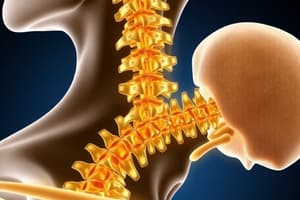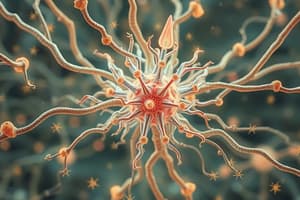Podcast
Questions and Answers
What is the role of the afferent fibers in the trigeminal pathway?
What is the role of the afferent fibers in the trigeminal pathway?
- To synapse with the trigeminal nuclei for motor function
- To relay information directly to the primary sensory cortex
- To carry information from the receptors to the brainstem (correct)
- To transmit sensory information to the spinal cord
What sensory function is lost with a lesion in area 3b of the primary somatosensory cortex?
What sensory function is lost with a lesion in area 3b of the primary somatosensory cortex?
- Ability to discriminate fine tactile details (correct)
- Ability to recognize familiar textures
- Ability to identify three-dimensional shapes
- Ability to perceive temperature changes
Where does the signal travel after reaching the trigeminal nuclei?
Where does the signal travel after reaching the trigeminal nuclei?
- To the thalamus for further processing (correct)
- To the cerebellum for coordination
- Directly to the spinal cord
- To the basal ganglia for reflex actions
Which neuron type is primarily responsible for identifying an object's quality during stereognosis?
Which neuron type is primarily responsible for identifying an object's quality during stereognosis?
In which area is tactile and proprioceptive information integrated?
In which area is tactile and proprioceptive information integrated?
What aspect of the primary somatosensory cortex (SS cortex) is primarily noted in the document?
What aspect of the primary somatosensory cortex (SS cortex) is primarily noted in the document?
What does the columnar representation in the SS cortex indicate?
What does the columnar representation in the SS cortex indicate?
Which of the following structures receives incoming sensory afferent information?
Which of the following structures receives incoming sensory afferent information?
Flashcards
Stereognosis
Stereognosis
The ability to identify objects through touch alone.
Area 5 Integration
Area 5 Integration
Area 5 integrates information from both touch (tactile) and movement (proprioceptive) senses, allowing for a complete understanding of object interactions.
Somatosensory Cortex
Somatosensory Cortex
The primary somatosensory cortex receives initial sensory signals, while the secondary higher somatosensory cortex further processes and identifies information.
Columnar Representation of SS Cortex
Columnar Representation of SS Cortex
Signup and view all the flashcards
Pyramidal Cells
Pyramidal Cells
Signup and view all the flashcards
Branches of the Trigeminal Nerve (CN V)
Branches of the Trigeminal Nerve (CN V)
Signup and view all the flashcards
Primary Somatosensory Cortex (SI)
Primary Somatosensory Cortex (SI)
Signup and view all the flashcards
Spinal Trigeminal Nucleus
Spinal Trigeminal Nucleus
Signup and view all the flashcards
Trigeminal Pathway
Trigeminal Pathway
Signup and view all the flashcards
Lesion 3b
Lesion 3b
Signup and view all the flashcards
Study Notes
Sensory Pathways
- Stereognosis: ability to identify objects by touch, involving 3b neurons and comparison to previous experiences to deduce shape, size, and other features of objects
- Accurate tactile quality is needed to distinguish objects based on their shape, size and other features.
- The size of the objects also plays a role in being able to distinguish the shape
- Different neurons identify various aspects of objects
- Information from the skin (touch) and proprioceptive information from muscles and joints combine to create perception.
Flow of Sensory Information
- Information on the skin and muscles/joints passes through the thalamus (VP) to the primary sensory cortex (SS).
- Neurons pass through posterior dorsal area of the thalamus (VP)
- There is an interplay between information from different sources - touch and proprioception, eye movements also take part in processing.
- Sensory information from the body is sent to the primary sensory cortex and then further processed in association areas.
- Processing of touch, pain, and temperature is further processed
- Cortical neuron involvement leads to the identification of objects
- The secondary (higher) sensory cortex receives input from SS and other areas. This is where complex perceptions, like stereognosis, are formed.
- A descending pathway from the motor cortex influences sensory processing.
Cortical Representation
- The representation of sensory information in the cortex is organized topographically.
- Different parts of the body are represented in distinct areas of the cortex.
- Neurons in the cortex are organized into columns.
- In the somatosensory cortex (S1), this columnar organization is present (columns of neurons receiving input from small areas of skin).
- Information from different parts of the body travels to different columns of the S1 cortex.
Sensory Lesions
- Lesions in the primary sensory cortex can affect the ability to discriminate between different tactile stimuli.
- Lesions in the higher sensory areas affect complex perceptions like stereognosis.
- In contrast lesions in the higher sensory areas produce a disturbance in the perception of spatial features instead of the ability to perceive individual stimuli.
- Lesions also cause contralateral effects in sensory processing
Studying That Suits You
Use AI to generate personalized quizzes and flashcards to suit your learning preferences.




